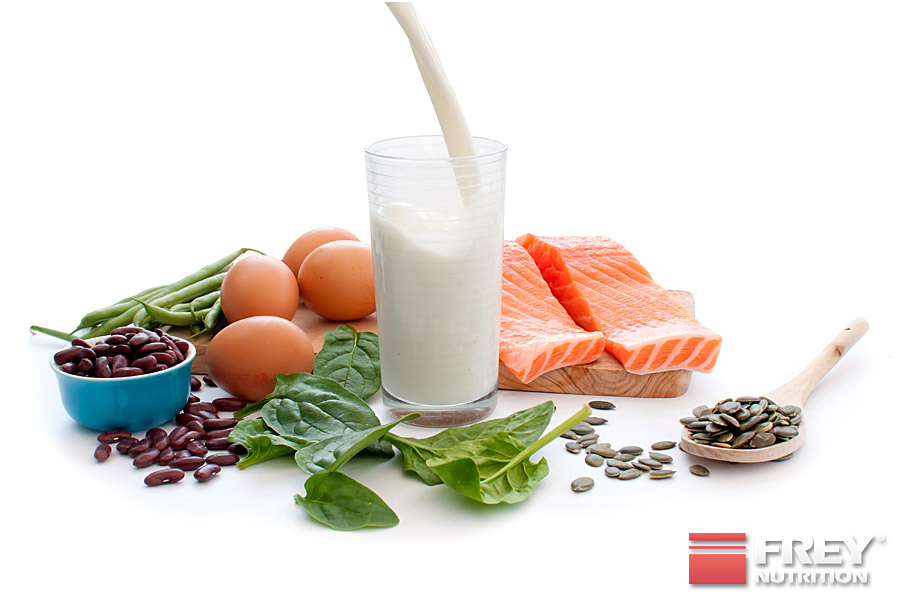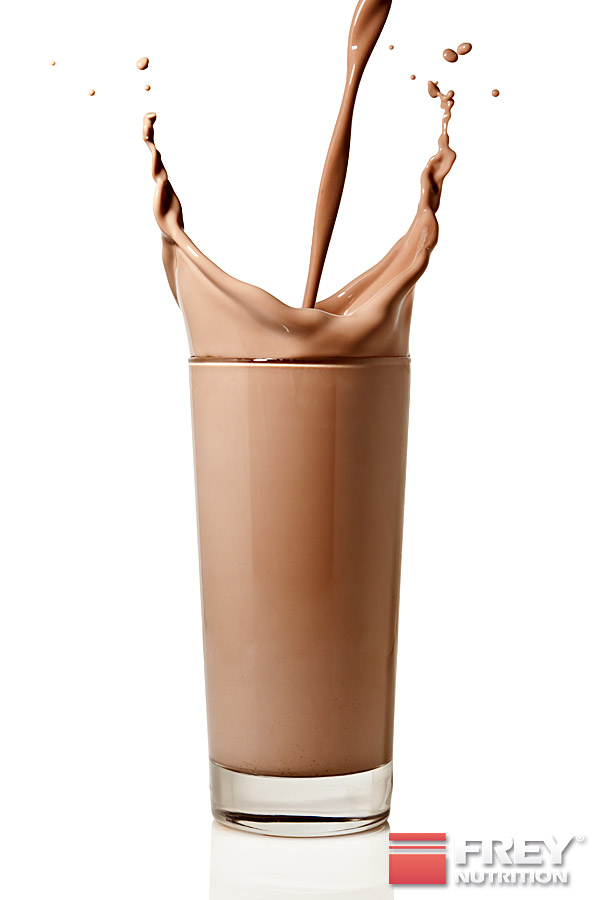PROTEIN | THE MOST IMPORTANT NUTRIENT IN OUR FOOD
THE BASIC BUILDING MATERIALS OF ALL CELLS
Proteins are the basic building blocks of the cells of all living things. That is why they are also called PROTEINS (Greek Protos = the first), because they are the first and therefore most important substances; because without protein there is no growth and no life. Proteins consist of a large number of individual amino acids which are linked together to form a chain. Although there are countless amino acids, most of them are still unexplored and only 20 in total are of importance to humans. As with other nutrients, there are also amino acids that the human body cannot produce itself (essential amino acids), so they must be supplied from outside with food.
Protein structures are constantly being built up, broken down and rebuilt in the body. Normally, there is a dynamic balance between the building up (= anabolic) on the one hand and the breakdown (= catabolic) on the other. Due to the constant building up and breakdown of protein, there is an amino acid reserve of 600 to 700 g in the intermediate metabolism, which is known as the amino acid pool. This is the body's only protein reserve that is constantly available. There are no other stores, as is the case with carbohydrates and fats.
THE OPTIMAL PROTEIN AMOUNT
The protein in food has the task of supplying amino acids to build the body's own proteins. The need for individual amino acids varies depending on the situation in life and physical exertion, with the greatest need being during growth phases. Protein, amino acids and BCAAs are so important for athletes because the body is constantly building up and breaking down and is dependent on sufficient and regular external intake. 1 gram of protein contains 4.1 calories. The optimal protein content of (athlete's) food is around 30%. However, as with carbohydrates and depending on the type of diet, this value can vary between 10 and 50%.
PROTEIN CAN INCREASE METABOLISM BY UP TO 30%!
PROTEIN FOR AN ACTIVE METABOLISM
The energetic digestive loss of a high protein consumption can increase significantly due to the protein-dependent thermogenic effect (thermogenesis = increase in body temperature). The postprandial thermogenesis (indicates how high the temperature increase is immediately after a meal = increase in metabolism) is
- a high-fat meal at about 4%,
- a carbohydrate-rich meal at 7% and
- a protein-rich meal between 25 to 30%.
Through increased protein intake, our body (at rest and without additional exercise) burns significantly more calories than through the same amount of calories in the form of fat or carbohydrates. *(see: JOHNSTON CS, DAY CS, SWAN PD. THERMIC EFFECT OF HIGH-PROTEIN DIETS. FASEBJ 2001;15(4):A755.6. )
This property supports fat loss during weight-loss diets and should therefore be observed and implemented. Well-informed athletes, such as bodybuilders and fitness athletes, as well as those who want to go on a diet, take advantage of this positive effect on their metabolism and increase the protein content of their diet in a targeted manner - on the one hand to reduce body fat and on the other hand to preserve lean muscle mass in a diet. Since muscles consist largely of protein, increased protein intake contributes to muscle maintenance.
THE INDIVIDUAL PROTEIN REQUIREMENT
For athletes, the average protein requirement is around 2 g/kg body weight and varies between 1.5 and 3.0 g/kg body weight per day depending on the sport and the intensity of the physical activity. In some situations, for example during diet or build-up phases, an increased training schedule, and for advanced athletes and competitive athletes, protein intake can often rise to up to 4 g/kg body weight and more. The often-heard claim that the human body can only use around 30 g of protein per meal is not only completely unfounded, but simply confuses the facts. The fact that our body can absorb 30 g of protein per hour is considered to be proven. Theoretically, 90 g of protein per meal can be easily absorbed by the intestines every three hours. However, many other factors also play a decisive role in protein intake, requirements and utilization:
- the genetic predisposition (individual predisposition)
- body weight
- the (lean) muscle mass percentage
- the intensity, duration and frequency of training and
- the current training status and progress
These factors determine, among other things, the individual body's ability to efficiently utilize protein. In general, it can be assumed that a protein portion of 50 to 70 g can be easily utilized per meal by light to medium-weight athletes (with a body weight of around 70 kg) and 70 to 90 g by strong athletes (with a body weight of around 90 kg and above).
The damaging effect of increased protein intake on the kidneys, which is often erroneously claimed, has not been proven in a single scientifically supported study and, like the maximum possible protein amount of 30 g per meal, comes from the land of old wives' tales. (See the following study: D. KALMAN AND J. ANTONIO: "THE EFFECTS OF A HIGH PROTEIN INTAKE ON MARKERS OF HEALTH IN WEIGHT TRAINED ATHLETES", FASEBJ 200; 15(4):A631.14. )
THE OPTIMAL FLUID INTAKE IS ONE LITRE PER 20 KILOGRAMS OF BODY WEIGHT PER DAY.
FLUID INTAKE WITH INCREASED PROTEIN INTAKE
It is important to drink enough fluids when increasing protein intake, as protein is excreted via the kidneys and sufficient fluid is needed for this process.
One liter of fluid (preferably still water) per 20 kg of body weight per day is recommended for an optimal fluid balance - this applies to both men and women. A person weighing 80 kg would therefore need to drink 4 liters per day to adequately cover their fluid requirements and, as a result, ensure optimal protein utilization and maintain physical performance. Since sporting activities often cause sweating, an additional liter of fluid should be consumed for every hour of sport.
THE BENEFITS OF PROTEIN
Protein in the form of nutritional supplements has become indispensable in sport and almost all performance-oriented athletes from all sports successfully use protein products every day to optimally and sufficiently supply their bodies with essential proteins. Since they can be prepared and consumed quickly, conveniently and anywhere, protein concentrates make daily protein intake much easier. As mentioned at the beginning, protein consists of a large number of amino acids, 20 of which are particularly important for our body. These include, for example, BCAAs (= the branched-chain amino acids L-leucine, L-isoleucine and L-valine), L-glutamine, L-arginine, L-cysteine, L-tyrosine, etc. The individual amino acids are linked together to form chains, which are also known as peptides and are found, for example, in amino acid products. The shorter the amino acid chains of a protein, the easier it is digested and absorbed into the muscle cells.
PROTEINS CONTRIBUTE TO MUSCLE BUILDING AND MAINTAINING
Proteins are very important for muscle building and regeneration because they protect and build muscle cells and repair damaged muscle fibers. The literature assumes that proteins can have the following functions in sports:
BEFORE THE TRAINING
- Reduction of muscle loss
- fast energy reserve under heavy loads
- Reduction of stress hormones such as adrenaline and cortisol
- Stabilization of blood sugar levels during heavy exercise
AFTER TRAINING
- Support muscle building
- shortened cell regeneration time
- Degradation and detoxification of metabolic end products
THE MUSCLE-PROTECTIVE EFFECT OF PROTEINS
During intensive training, the muscles are strained and irritated. The muscle is not used to this strain and must adapt to protect the muscle fibers from renewed strain. This adaptation (= adjustment), caused by the growth stimuli of training, causes the rebuilding and building of new muscle mass. The muscle fibers are wrapped in new "strands", making them firmer and larger. A muscle strand consists of thousands of muscle fibers that can be rebuilt using proteins (see also: THE MUSCULATURE ).
In order to build muscle mass, protein building blocks are required from outside as building material. Only when these are supplied in sufficient quantities through food or in the form of nutritional supplements can new muscles be built up. However, an adequate supply of protein and amino acids is not only important for muscle building processes, it also plays an important role in protecting muscles during diet phases.
By preventing the breakdown of muscle proteins for energy production, protein contributes to muscle maintenance. BCAAAS L-leucine, L-isoleucine and L-valine are relevant for this protection because they are used as energy before muscle tissue during intense physical exertion.
PROTEINS IN ENDURANCE SPORTS
Proteins and their building blocks also play an important role in endurance sports. Studies have shown that during intensive and long-lasting muscular exertion, protein building blocks are increasingly used in the body to generate energy.
The studies also confirm the muscle-degrading effect during and after intensive exercise (Williams, 1997, Ferreira et al., 1997, Mero, 1999, Coombes et al., 2000) . Through the regular supply of protein building blocks, the body can rely on them more and protect the muscles from breakdown processes. According to the study, amino acids are supposed to protect the body's glycogen reserves, prevent a premature drop in performance due to a lack of energy and prolong endurance during training.
THE BIOLOGICAL VALUE
The biological value of dietary proteins indicates how many grams of body protein can be built up from 100 g of the relevant dietary protein. The higher the biological value of a protein, the less the human body needs to keep its protein balance stable. In principle, animal protein is of higher biological value for humans than plant protein, as animal protein is more similar to human protein and can therefore be more easily converted into muscle protein. The reference value is the whole egg with a biological value of 100.
| Animal protein | BW | Vegetable protein | BW |
| Whey protein* | 104-110 | soy | 84 |
| Whole egg (reference) | 100 | rye | 76 |
| beef | 92 | Beans | 72 |
| Cow's milk | 88 | potatoes | 76 |
| Fish (tuna) | 86 | rice | 70 |
| Edam cheese | 85 | Bread | 70 |
| yogurt | 83 | oatmeal | 60 |
| Quark | 81 | wheat flour | 56 |
| Pig | 76 | cornflakes | 54 |
| Salmon | 75 | Peas | 43 |
| Gelatin / Collagen | 0 | lenses | 33 |
* TRIPLE WHEY (Whey concentrate, whey isolate and whey hydrolysate)
THE BW INDICATES HOW MANY GRAMS OF BODY PROTEIN CAN BE BUILD BY 100 G OF DIETARY PROTEIN
By mixing individual proteins, the biological value of the total protein can be increased considerably. The combination of around 65-75% milk, 20-25% whey and 5-10% egg protein achieves the highest measured biological value of over 136, which significantly exceeds that of whole egg of 100.
| Protein mix | Percentage | BW |
| Beans and corn | 52% / 48% | 101 |
| Milk and wheat | 75% / 25% | 105 |
| Whole egg and wheat | 68% / 32% | 118 |
| Whole egg and milk | 71% / 29% | 122 |
| Whole egg and soya* | 60% / 40% | 124 |
| Whole egg and potatoes | 36% / 64% | 136 |
| Milk, whey and whole egg** | 70% / 25% / 5% | > 136 |
* MEGA PROTEIN (Egg protein and soy protein isolate 60/40)
** PROTEIN 96 (Milk, whey isolate/concentrate and egg protein 70/25/5)
SUGGESTED TIMES FOR PROTEIN INTAKE
Protein immediately after getting up- Fast proteins* such as whey protein, whey isolate, hydrolysates.
Protein as a snack
- Slow proteins** such as multi-component protein (protein matrix made from milk, whey and egg protein).
Protein before training
- Fast protein such as whey protein or better whey isolate, liquid amino acids and BCAAs in capsule or powder form.
Protein after training
- Fast protein such as whey protein or whey isolate, liquid amino acids, BCAAs in powder or capsule form and glutamine (see also: THE INSULIN THEORY or post-workout nutrition )
Protein before going to bed
- Slow proteins such as milk protein and multi-component protein
* Fast proteins are those with a very rapid protein absorption into the blood
** slow proteins are absorbed slowly and lead to a longer protein supply (see: THE DIFFERENT TYPES OF PROTEINS )
The decisive factor for a slow protein with delayed absorption is a more than 60% share of slow protein fractions, such as milk protein. Due to the constant protein supply, milk protein is ideal as a "night protein" before going to bed. Due to the mixture of different protein raw materials, a good multi-component protein offers the quality advantage of increased biological value compared to casein/milk protein as a mono-protein and is always preferable to the latter.
In order to ensure a balanced protein supply to the muscle cells, the daily required amount of protein should be distributed evenly over 4 to 5 meals throughout the day. This avoids protein fluctuations in the amino acid pool and provides the body with a consistent supply of building materials.
PROTEINS IN COMPETITION PREPARATION
Competition preparation can be optimally supported with the right nutrition. This applies not only to bodybuilders, but also to fitness athletes.
Careful planning is the basic requirement for successful competition preparation. By always keeping an overview of the daily amount of food and calories, keeping a food diary is of considerable importance for the implementation of the plan and is therefore particularly recommended. This ensures 100% control of the daily diet and thus enables the right decisions to be made in the event of stagnation. There are three phases in competition preparation, which are explained in more detail below:
1. THE CONSTRUCTION PHASE
The build-up phase of competition preparation is all about maximum muscle mass gain. While body fat gain cannot be completely avoided during this phase, it can at least be kept somewhat within limits so that the fat gained during the build-up phase does not have to be laboriously lost again. The diet during the build-up phase is characterized by a high intake of complex carbohydrates such as rice, pasta, potatoes, bread and carbohydrate powder in the form of maltodextrin. Many bodybuilders resort to weight gainers here in order to cope with the increased calorie intake and to relieve the digestive system through the large amount of food intake.
In addition to carbohydrates, protein shakes are increasingly consumed in order to provide a sufficient amount of building blocks for muscle growth. Athletes often PROTEIN 96 is used as a basic protein, which is drunk between or with meals and especially before going to bed. After training, a good whey protein like TRIPLE WHEY because it provides the body with important amino acids for muscle building within a few minutes and thus makes a decisive contribution to the development of new muscle mass.
In addition to carbohydrates and proteins, minerals, vitamins, trace elements and sufficient fluid intake are also essential. The building phase is not the eating phase. Fast food, high-fat foods and foods with a high sugar content should be avoided as these hinder lean muscle building.
2. THE DEFINITION PHASE
In this phase, the goal is to break down the body's own fat reserves as much as possible. Due to their advantages, protein shakes are particularly important during the definition phase. While protein-rich foods usually contain a significant amount of carbohydrates and fats in addition to protein, protein shakes ensure the intake of biologically high-quality proteins - but without any fat or carbohydrates.
EGG PROTEIN is a very popular protein in this phase because the high proportion of sulfur-containing amino acids it contains can positively support fat loss in a diet. Egg protein is 100% lactose-free and does not retain water under the skin, making it an optimal competition protein.
ACCORDING TO STUDIES, THE CALCIUM CONTAINED IN DAIRY PRODUCTS CAN POSITIVELY SUPPORT FAT LOSS.
During the definition phase, dairy products can be consumed without any concerns. Milk protein is actually very useful during this phase, as the calcium it contains has been proven to have a positive effect on fat loss.
Two weeks before a competition, however, all dairy foods should be removed from the diet plan to be on the safe side, as the lactose in milk can cause water to accumulate under the skin in sensitive athletes. In order to cover the increased protein requirements of the definition phase, in addition to protein shakes, amino acid products with free amino acids and BCAAs (branched chain amino acids) such as ANABOLIC BCAA + and BCAA TABS used.
The food should taste good, otherwise the life of a bodybuilder and strength athlete quickly becomes torture, which also increases the risk of giving up on the diet! This includes not only meat and protein shakes, but also vegetables. Broccoli, cauliflower and most vegetables have hardly any calories, few carbohydrates and almost no fat. With vegetables, good oils, nuts, seeds and meat, meals can be made varied, low in carbohydrates and high in protein.
3. THE COMPETITION NUTRITION OF THE LAST 4 WEEKS
During the last 4 weeks before a competition, carbohydrate intake is gradually reduced, as carbohydrates retain water and can hinder fat burning. A lot of protein and a small amount of carbohydrates (approx. 50 to 100 g daily) such as rice, oatmeal and/or potatoes characterize the diet during this phase. Protein-rich foods are consumed exclusively in the form of low-fat meat such as chicken, turkey, fish and protein shakes.
Egg protein, which is used in MEGA PROTEIN is also frequently used in this phase because it does not retain water under the skin, has a high biological value in combination with soy protein isolate and is therefore a very popular competition protein.
In the last 7 days before a competition, fats and proteins are further increased and carbohydrates are reduced to less than 20 g per day, only to be drastically increased again 2 days before day X. This process, which is also known as the "unloading/loading phase", causes thin skin and plump and defined muscles through glycogen supercompensation of the muscle cells. For the bodybuilder, these are the best conditions for a successful competition placement!


















